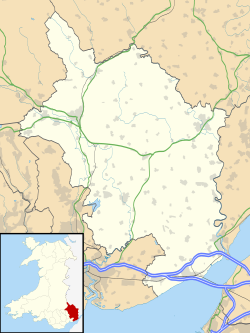Llanvetherine
| |
|---|---|
 Church of St James the Elder | |
Location within Monmouthshire | |
| OS grid reference | SO364172 |
| Community | |
| Principal area | |
| Preserved county | |
| Country | Wales |
| Sovereign state | United Kingdom |
| Post town | ABERGAVENNY |
| Postcode district | NP7 |
| Dialling code | 01873 |
| Police | Gwent |
| Fire | South Wales |
| Ambulance | Welsh |
| UK Parliament | |
Llanvetherine (Welsh : Llanwytherin) is a village in the community of Skenfrith, Monmouthshire, Wales. It is located five miles north east of Abergavenny on the B4521 road to Ross-on-Wye. The name comes from the Welsh Saint Gwytherin.
